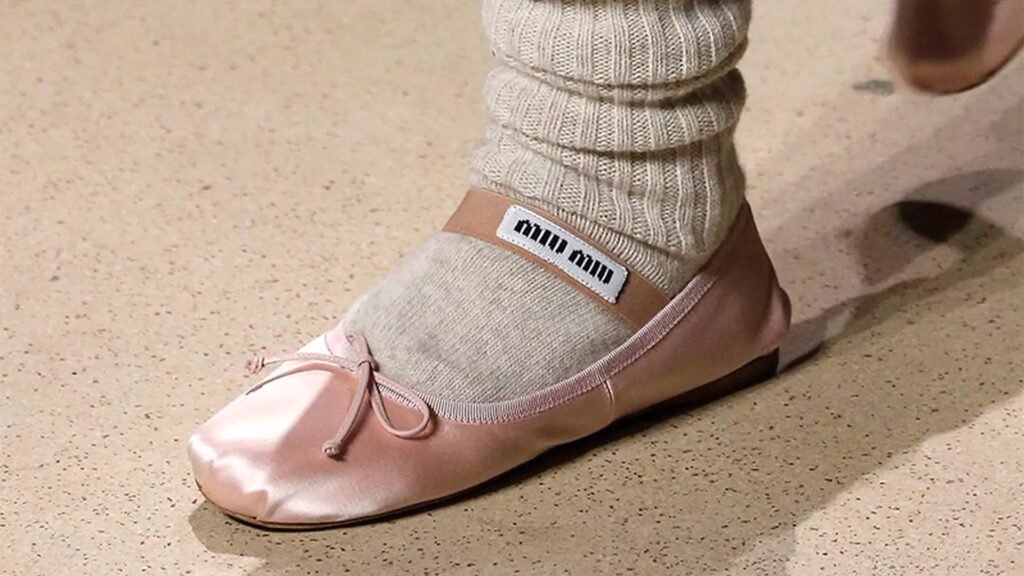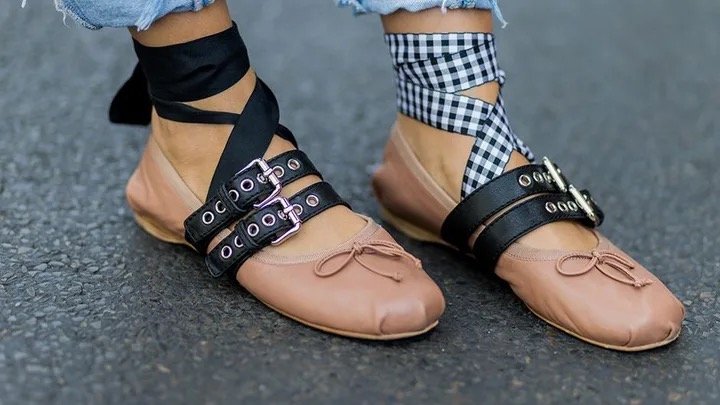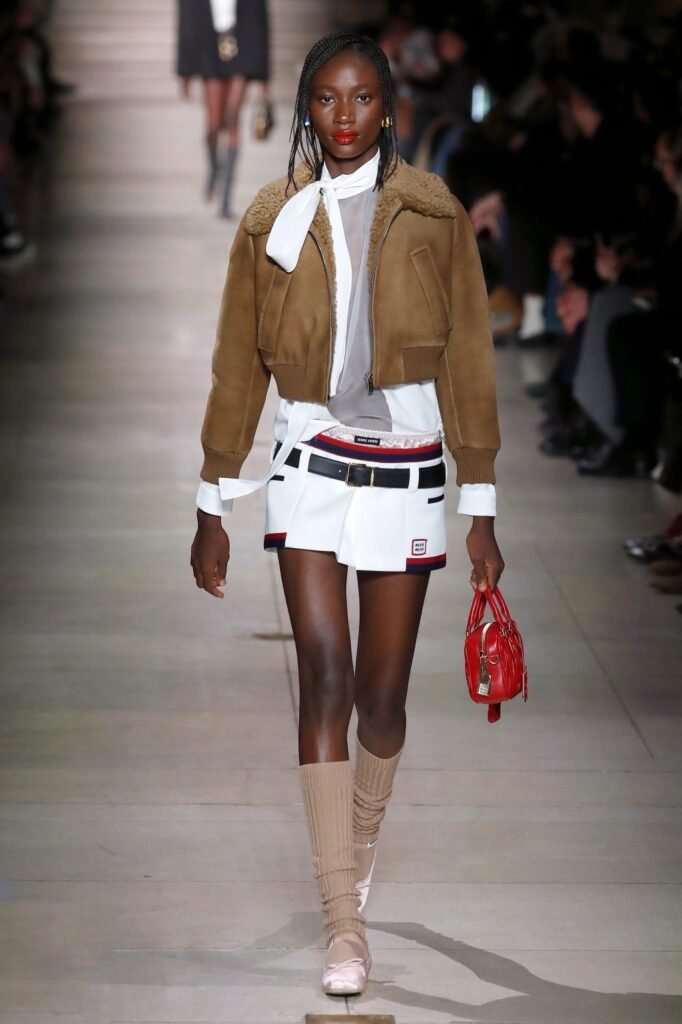In recent years, few fashion items have encapsulated the intersection of luxury, nostalgia, and contemporary femininity as effectively as Miu Miu’s ballet flats. Once a symbol of simplicity and practicality, the ballet flat has re-emerged as an emblem of cultural sophistication and understated affluence. Through strategic design, digital influence, and shifting aesthetic values, Miu Miu transformed this modest shoe into a statement of identity and aspiration. This essay examines the cultural, psychological, and economic dimensions of this transformation, exploring how the ballet flat evolved from a traditional form of footwear into one of the most recognisable symbols of modern luxury.
Reinterpereting Tradition: The Rebirth of the Ballet Flat
Miu Miu, the youthful counterpart of the Italian fashion house Prada, reintroduced ballet flats in its 2022 collections with a distinct reinterpretation of classic femininity. The brand’s creative director, Miuccia Prada, reimagined the shoe not as a nostalgic reference to childhood but as a fashion object that merges fragility and authority. The satin material, elasticised straps, and muted colour palette gave the shoe a delicate appearance, yet its association with Miu Miu’s daring silhouettes and cropped ensembles created a deliberate tension between innocence and control.
This tension resonated strongly with contemporary audiences. Social media platforms, particularly TikTok, amplified the aesthetic through the popularity of trends such as “balletcore” and “coquette style”. Within months, the Miu Miu ballet flat became a visual shorthand for the new feminine aesthetic that blends softness with confidence. Its success demonstrates how a simple object can acquire complex symbolic meaning when aligned with broader cultural shifts in gender identity and self-expression.

Cultural Shifts and the Reimagining of Femininity
The resurgence of the ballet flat reflects a wider cultural movement in which femininity is being consciously redefined. During the early 2000s, ballet flats were associated with preppy fashion and upper-middle-class respectability, popularised by figures such as Alexa Chung and fictional characters like Blair Waldorf. At that time, the shoes symbolised refinement and adherence to traditional fashion ideals. However, by the 2010s, they had fallen out of favour, replaced by sneakers, boots, and more overtly masculine footwear that reflected changing gender norms.
The 2020s have seen a reversal of this pattern. The rise of aesthetics centred on delicacy, restraint, and romanticism indicates a cultural desire to reclaim forms of femininity that had previously been dismissed as frivolous. For members of Generation Z, the ballet flat embodies control rather than submission. It allows wearers to engage with historically feminine imagery while asserting autonomy over its meaning. Miu Miu’s ability to capture this mood has positioned the brand as a leading influence in redefining what contemporary femininity looks like.
In this context, the Miu Miu ballet flat functions as both a product and a cultural statement. It reflects how fashion operates as a social language, translating emotional and ideological currents into tangible forms. The shoe’s widespread popularity is therefore not merely a matter of aesthetic preference but evidence of a generational shift in how softness and strength coexist within the female identity.
The Aesthetic of Discreet Luxury
One of the defining characteristics of Miu Miu’s ballet flats is their subtle presentation. Unlike the overt logos and embellishments of early 2010s luxury fashion, these shoes exemplify what industry observers have called “discreet luxury.” They convey exclusivity not through visible branding but through craftsmanship, scarcity, and cultural recognition. This aesthetic aligns with the broader movement towards quiet status symbols, a trend intensified by social media fatigue and the public’s increasing awareness of consumerism.
Owning a pair of Miu Miu ballet flats signals access to a specific cultural economy rather than mere financial privilege. The shoes are typically paired with understated outfits such as wool cardigans, linen skirts, or vintage denim. This deliberate pairing communicates taste, restraint, and discernment. The value of the object lies not only in its material quality but in its symbolic capital, it marks the wearer as someone who understands fashion beyond its surface level.
From an economic standpoint, Miu Miu’s approach demonstrates the power of scarcity and cultural resonance in luxury branding. By limiting supply and fostering a sense of insider exclusivity, the brand maintains desirability without overt advertising. This strategy mirrors the consumption patterns of a generation increasingly drawn to authenticity and self-curated luxury. The ballet flat, in this sense, is both a fashion item and a vehicle for social distinction.

The Symbolism and Limitations
The success of Miu Miu’s ballet flats also reveals the complexities of cultural symbolism in fashion. On one hand, the shoes represent empowerment through the reclamation of traditionally feminine aesthetics. They suggest that softness and vulnerability can coexist with authority and independence. However, this interpretation is not universally accepted. Critics argue that the trend perpetuates class and gender ideals rooted in Eurocentric standards of beauty. The association of ballet-inspired imagery with privilege and refinement raises questions about inclusivity and accessibility in luxury fashion.
Moreover, the economic exclusivity of the trend limits its broader impact. A pair of Miu Miu ballet flats typically costs close to one thousand dollars, placing them well beyond the reach of most consumers. While fast fashion retailers have produced inexpensive imitations, these lack the symbolic power of the original product. This division underscores how luxury brands maintain their status by controlling not only price but also meaning.
Another challenge lies in the rapid pace of digital fashion cycles. Online trends evolve quickly, and what is aspirational today can become oversaturated tomorrow. The widespread replication of Miu Miu’s design by other brands and influencers risks diluting the flat’s cultural value. Once an object becomes ubiquitous, it loses the exclusivity that made it desirable. Therefore, the ballet flat’s position as a status symbol may be temporary, reflecting the transient nature of twenty-first-century fashion consumption.

Miu Miu’s ballet flats represent far more than a revival of a classic shoe. They illustrate how fashion operates as a reflection of cultural psychology, social identity, and economic aspiration. Through a careful balance of nostalgia, subtlety, and strategic marketing, Miu Miu transformed a symbol of simplicity into an emblem of contemporary sophistication. The ballet flat’s success demonstrates that luxury today is defined less by conspicuous display and more by coded knowledge and emotional resonance.
Written By: Mia Quisumbing
Published On: 12th November 2025